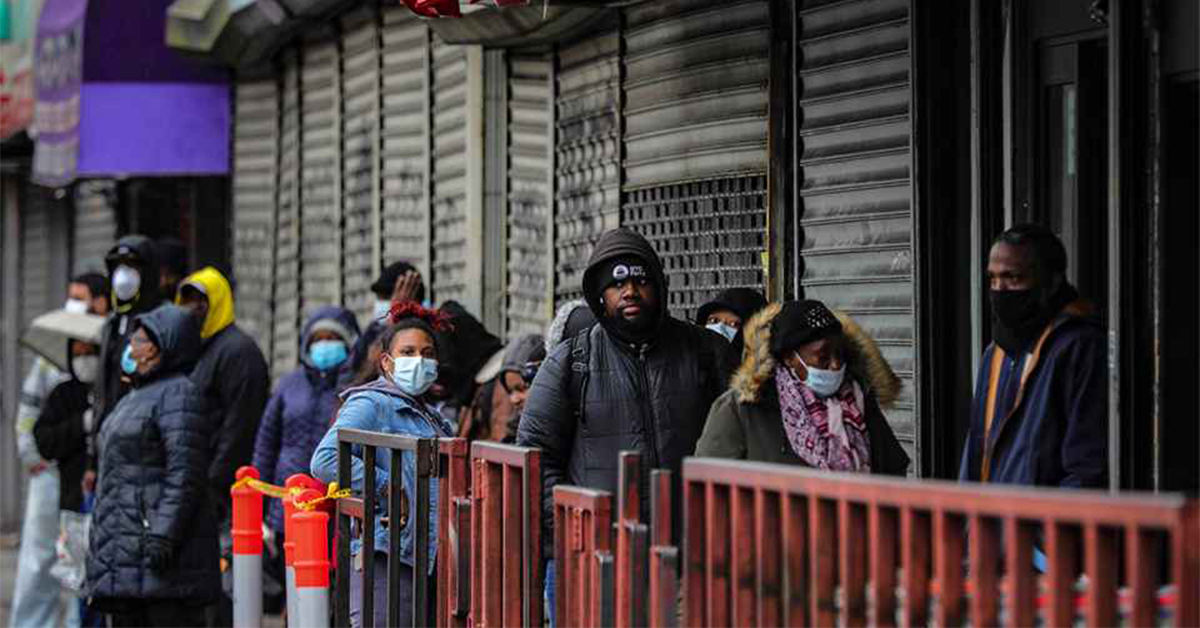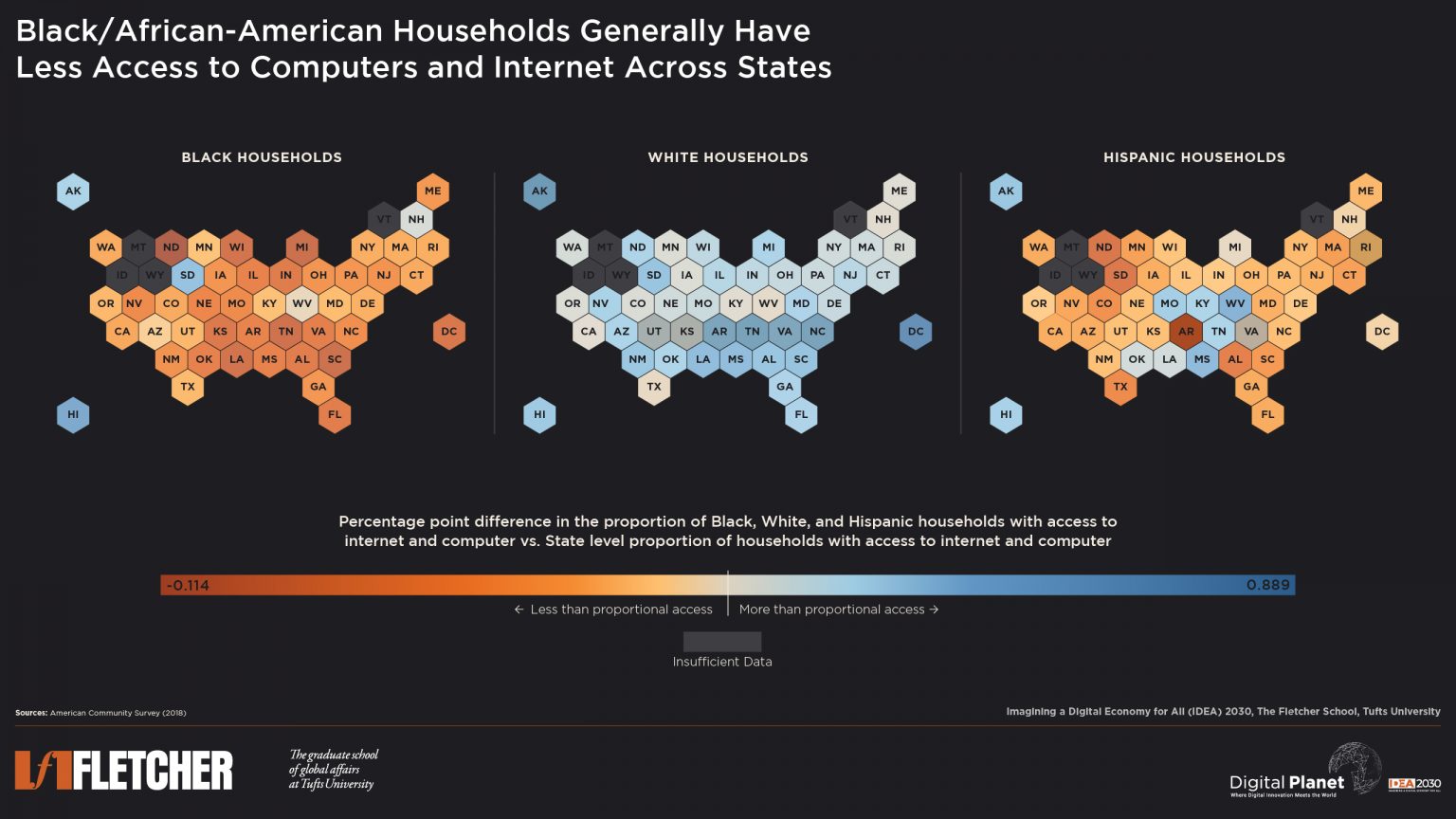Digital Injustice: Disparities in Digital Access across the US and How they Disproportionately Hurt the Black and Latino Communities
Home > Off the Charts > Uneven State of the Union > Digital Injustice: Disparities in Digital Access across the US and How they Disproportionately Hurt the Black and Latino Communities.
Digital Injustice: Disparities in Digital Access across the US and How they Disproportionately Hurt the Black and Latino Communities.
The COVID-19 pandemic has laid bare longstanding and systemic issues of inequality in the United States. Certain marginalized races and ethnicities (Black or African American and Hispanic or Latino households) are over-represented in less-flexible, low-tech, and “high-touch” occupations and under-represented in the information economy and “high-tech” occupations; an outcome of decades of disparity in access to critical digital services like stable and affordable internet and computers.
Unemployment rates by race and ethnicity in May 2020: Job losses deepening for Black and Latino workers
The COVID-19 pandemic has impacted three groups of people in vastly different ways: the unemployed, who are out of work and unable to earn a wage; frontline and essential workers, who are at higher risk of exposure to the virus; and workers with flexible and digitized jobs that allow them to work from the safety of their homes. Black or African American and Hispanic or Latino workers are over-represented in the first and second categories and significantly underrepresented in the third category.
Even though the national unemployment rate fell from 14.7% in April 2020 to 13.3% in May 2020 (with a drop in the unemployment rate for white workers from 14.2 % to 12.4%), unemployment for African American and Asian workers increased slightly from 16.7% to 16.8% and 14.5% to 15%, respectively. And while unemployment for Hispanic workers decreased from 18.9% to 17.6%, they comprised the highest proportion of the unemployed.
A post-pandemic recovery for communities living on the margins will be longer and more arduous––these communities were already economically fragile and have continued to be disproportionately impacted by and exposed to the virus (in April 2020, 30% of COVID-19 patients had been African American, even though African Americans comprise only 13% of the total population in the US).
Workforce representation by race and ethnicity in highly digital occupations
While nearly all occupations have been adversely impacted by the pandemic, the less digital, more high-touch occupations saw greater increases in unemployment. There is a sharp variation in the employment profiles of racial and ethnic groups, with the graph showing the percent of workers over or underrepresented relative to their baseline composition in the total workforce nationally.
Asian workers are just 6.5% of the workforce but account for 38% of highly digital, higher-paying software developer jobs and approximately 14% of management analyst jobs. Black or African American workers, meanwhile, comprise 12.3% of the workforce but are vastly overrepresented in less digital occupations, such as security guards (30%), food preparation and serving (20%), and personal care aides (25%). Similarly, while Hispanic or Latino workers make up 17.6% of the workforce, they are heavily overrepresented in less digital, lower-paying occupations such as construction laborers (47%), mechanics (28%), and personal care aides (22%).[1]
[1] Estimates for the above race groups (White, Black or African American, and Asian) do not sum to totals because data are not presented for all races. Persons whose ethnicity is identified as Hispanic or Latino may be of any race.
Moreover, Black or African American workers and Hispanic or Latino workers are substantially underrepresented in higher-pay, high-tech occupations in fields like engineering, business, and finance, and are also underrepresented (albeit to a lesser extent) in medium-tech legal and educational roles.
Workers in high-tech occupations are better placed to handle the pressures of social distancing measures and office shutdowns and can transition to working from home with relative ease. In 2018, a third of all white workers and almost 40% of Asian workers were in jobs where they could work from home. On the other hand, less than 20% of Black or African American workers and only 16% of Hispanic or Latino workers were in jobs that lend themselves to working from home.
While digitalization presents considerable opportunities for historically marginalized workers to climb up the employment and socio-economic ladder, too few of these workers appear to be making progress. The reason for this persistent gap is decades of disparity in access to critical digital services like stable and affordable internet and computers.
Access to computers and internet connection by race and ethnicity
The COVID-19 pandemic has laid bare longstanding and systemic issues of inequality in the country including the lack of adequate reach of affordable internet to Black and Hispanic households. Not only do Black and Hispanic households have less flexible work environments, but they also have lower access to critical digital services like stable internet connections and computers compared to national averages and averages among White households. This disparity in access has an adverse impact not only on their ability to seek employment in the information economy but also on learning opportunities for children, young adults, and unemployed individuals looking for new work and/or building their skills.
The proportion of Black households that have access to computers (desktop/laptop, smartphone, or tablet) and internet connectivity are uniformly and disproportionately lower, compared to state averages and other racial/ethnic groups (Hispanic, White, and Asian households). This holds for almost all states across the country––Black or African American households, primarily, and Hispanic and Latino households, to a lesser extent, are equally likely to have unequal (substantially lower) computer and internet access.
Among states where data were available, Black or African American households with access to computers and an internet connection were, on average, 5 percentage points lower than the state average. Hispanic or Latino households are also at a disadvantage, but in fewer states and to a lesser degree.
Amidst a pandemic, with its widespread closures and steep unemployment rates, a lack of access to digital infrastructure disables large portions of the country from being able to search for work, completing school coursework online, accessing telehealth services for virtual care and consultations, participating in the gig economy, or filing for unemployment and insurance claims online––worsening an already persistent racial divide in the country.
The digital economy of the United States accounts for over 7% of its GDP today, and growing. Eliminating disparities in digital access creates new consumers of digital goods and services and contributors to the growth of the digital economy. Policymakers would do well to identify and address the “geographies of digital inequality,” where millions of Black and Latino households notably lack the requisite infrastructure to access digital goods and services, for the US to ensure an equitable economic recovery from this pandemic.
Key Observations and Insights
The COVID-19 pandemic has impacted three groups of people in vastly different ways: the unemployed, who are out of work and unable to earn a wage; frontline and essential workers, who are at higher risk of exposure to the virus; and workers with flexible and digitized jobs that allow them to work from the safety of their homes. Black or African American and Hispanic or Latino workers are over-represented in the first and second categories and significantly underrepresented in the third category.
Even though the national unemployment rate fell from 14.7% in April 2020 to 13.3% in May 2020 (with a drop in the unemployment rate for white workers from 14.2 % to 12.4%), unemployment for African American and Asian workers increased slightly from 16.7% to 16.8% and 14.5% to 15%, respectively. And while unemployment for Hispanic workers decreased from 18.9% to 17.6%, they comprised the highest proportion of the unemployed.
A post-pandemic recovery for communities living on the margins will be longer and more arduous––these communities were already economically fragile and have continued to be disproportionately impacted by and exposed to the virus (in April 2020, 30% of COVID-19 patients had been African American, even though African Americans comprise only 13% of the total population in the US).
While nearly all occupations have been adversely impacted by the pandemic, the less digital, more high-touch occupations saw greater increases in unemployment. There is a sharp variation in the employment profiles of racial and ethnic groups, with the graph showing the percent of workers over or underrepresented relative to their baseline composition in the total workforce nationally.
Asian workers are just 6.5% of the workforce but account for 38% of highly digital, higher-paying software developer jobs and approximately 14% of management analyst jobs. Black or African American workers, meanwhile, comprise 12.3% of the workforce but are vastly over-represented in less digital occupations, such as security guards (30%), food preparation and serving (20%), and personal care aides (25%). Similarly, while Hispanic or Latino workers make up 17.6% of the workforce, they are heavily over-represented in less digital, lower-paying occupations such as construction laborers (47%), mechanics (28%), and personal care aides (22%).
Estimates for the above race groups (White, Black or African American, and Asian) do not sum to totals because data are not presented for all races. Persons whose ethnicity is identified as Hispanic or Latino may be of any race.
Moreover, Black or African American workers and Hispanic or Latino workers are substantially underrepresented in higher-pay, high-tech occupations in fields like engineering, business, and finance, and are also underrepresented (albeit to a lesser extent) in medium-tech legal and educational roles.
Workers in high-tech occupations are better placed to handle the pressures of social distancing measures and office shutdowns and can transition to working from home with relative ease. In 2018, a third of all white workers and almost 40% of Asian workers were in jobs where they could work from home. On the other hand, less than 20% of Black or African American workers and only 16% of Hispanic or Latino workers were in jobs that lend themselves to working from home.
While digitalization presents considerable opportunities for historically marginalized workers to climb up the employment and socio-economic ladder, too few of these workers appear to be making progress. The reason for this persistent gap is decades of disparity in access to critical digital services like stable and affordable internet and computers.
Methodology
Data on Workforce Representation by Race and Ethnicity
The data on the workforce by race is pulled from the U.S. Bureau of Labor Statistics and covers the year 2019.
Over and under-representation of race within various occupations was calculated as the difference between the proportion of workers of that race in a specific occupation and the proportion of workers of that race in the total workforce.
Data on Access to Digital Services by Race and Ethnicity
The data on access to digital services by race and ethnicity are from the 2018 American Community Survey, U.S. Census Bureau. The chart shows the percentage point difference between the proportion of households in a state that has access to a computer and broadband internet connection and the proportion of households by race in the same state that has access to a computer and broadband access. Note that Idaho, Montana, Vermont, and Wyoming were not shown on the map due to insufficient data on Black or African American households.
All data and sources are available here.
Former Digital Planet Graduate Analysts Malavika Krishnan, Madhuri Mukherjee, and Devyani Singh worked on this analysis under the guidance of Bhaskar Chakravorti, Ravi Shankar Chaturvedi, Christina Filipovic, and Joy Zhang at Digital Planet, The Fletcher School, Tufts University.










